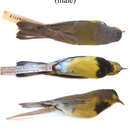en
names in breadcrumbs


Bachmans's Warbler (Vermivora bachmanii) was probably extinct by the 1980s, but it formerly bred in the bottomland forests and canebrakes of the southeastern United States and wintered almost exclusively in Cuba. The species was first collected by the Reverend John Bachman in South Carolina (U.S.A.) and formally described by his friend John James Audubon shortly thereafter in 1833. Bachman's Warbler was subsequently largely forgotten for half a century until it was rediscovered by Charles Galbraith, who shot several dozen over the course of several years and brought one to George Lawrence for identification (Lawrence 1887; Fuller 2002). For several decades after its rediscovery, Bachman's Warblers were encountered in fair numbers at several breeding locations and, during migration, in Florida. By 1920, however,Bachman's Warbler was scarce over most of its range and only a handful of breeding birds or migrants were encountered after 1930. The last undisputed sighting was of a single bird near Charleston, South Carolina, in 1962.
Information about the biology and ecology of Bachman's Warbler is limited. Most observations were made in the late 1800s and early 1900s when close attention was not often paid to habitat and the regions in which Bachman's Warblers bred and wintered had not yet been well explored ornithologically. The birds apparently foraged mainly between around 1 and 3 m high, gleaning small arthropods off vegetation and probing into leaf clusters. Singing males often sang from fairly high in trees. Hooper and Hamel (1977) extracted what information they could from (mostly unpublished) notes on the 40 nests they could identify from records. Nests were constructed less than around a meter off the ground in the dense understory of bottomland forest. The open cup nest was made of dead leaves, grass, moss, and weed stalks and lined with fine fibers such as those from Ramalina lichens and Spanish moss (Tillandsia usneoides). The 3 to 5 eggs were typically pure white, sometimes finely marked at the large end.
It is thought that breeding Bachman's Warblers favored small clearings and edges with a dense understory of Giant Cane bamboo (Arundinaria gigantea), brambles (Rubus spp.), Sabal Palm (Sabal palmetto), etc., often close to water. Remsen (1986) argued that they were likely Giant Cane specialists and depended on extensive canebrakes. Small-scale selective logging of bottomland forests in the late 19th century may have opened up clearings within forests and temporarily created additional breeding habitat, but by the early 20th century the species was in serious decline.Although the causes of this dramatic decline and apparent extinction of Bachman's Warbler are uncertain, there is a clear consensus that the major factor was the draining of swamps and the large-scale replacement of bottomland forests and canebrakes with agriculture (habitat loss in Cuba may also have been important, but virtually nothing is known about this). Bachman's Warbler may have always been relatively uncommon and therefore relatively vulnerable, although perhaps it was more common than generally realized as a consequence of its rather specialized breeding habitat and the fact that dense canebrakes were difficult to access. Other factors that have been suggested as possibly hastening the demise of the Bachman's Warbler are a series of destructive fall hurricanes in Cuba in the early 1930s and, possibly, the expansion of brood parasitism by Brown-headed Cowbirds responding to large-scale anthropogenic (i.e., human-caused) landscape changes.
Much of the original old literature about Bachman's Warbler is feely available (for personal use) from the Searchable Ornithological Research Archive (SORA). These articles from the late 19th and early 20th century effectively capture the excitement of basic discovery that was still in the air among "amateur" (and the few professional) ornithologists even in the United States at that time.
Hamel (1986, 1995) reviewed what we know about Bachman's Warbler and an excellent overview is also provided by Dunn and Garrett (1997). Hamel and Gauthreaux 1982 and Dunn and Garrett 1997 should be consulted for detailed information about distinguishing Bachman's Warblers from potentially similar-looking species.
(Dunn and Garrett 1997 and references therein)